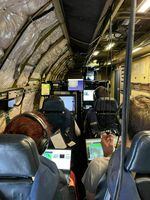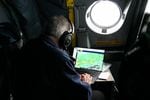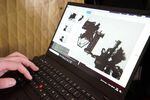
The P-3 investigation airplane leaving its hangar at NASA’s Wallops Flight Facility in Virginia.
Patrick Black / NASA
Higher up in some ice-loaded clouds, sitting inside an airplane loaded with science devices, Christian Nairy appeared at photographs flashing on his pc display. This higher-altitude slideshow is exhibiting serious-time visuals of cloud particles being sampled by a gadget out on the plane’s wing — and some of the ice crystals appeared like best very little snowflakes.
“They’re incredible to seem at. In particular when they pop up suitable in front of you on the display, it is really remarkable,” stated Nairy, a Ph.D. student at the University of North Dakota.
He’s just one of the experts who was aboard a investigation airplane previously this thirty day period as it flew out of NASA’s Wallops Flight Facility in Virginia to vacation through a winter storm — component of a research marketing campaign called IMPACTS, or the Investigation of Microphysics and Precipitation for Atlantic Coastline-Threatening Storms mission.

IMPACTS mission researchers inside of the investigate airplane, checking weather conditions info currently being gathered by onboard instruments.
Erica McNamee / NASA
It’s been collecting the form of facts that could sometime assistance temperature forecasters much better predict whether or not a winter storm may possibly cause treacherous circumstances that would have to have shutting down schools, closing streets, and canceling flights.
Right until this mission, which started in 2020 and finishes February 28, there hadn’t been a major airborne examine of wintertime storms in the eastern fifty percent of the United States in about 30 a long time, states Lynn McMurdie, an atmospheric scientist at the University of Washington in Seattle.
“We’ve had some truly fantastic storms,” says McMurdie. “Regardless of what Mother Character presents us, we will go fly in it. We are going out and striving to get the full range, from a super snowstorm that blocks all the targeted visitors up and down the East Coastline to ‘oh, this is just a normal rainstorm, why do you care?’ “
The most important storm they flew in was the blizzard in January of 2022 that dumped about 2 feet of snow on sections of the Atlantic coastline. “That was a crazy a person,” recalls Nairy. “We hit some ridiculous turbulence on that flight.”

On Jan. 29, 2022, a strong nor’easter introduced blinding blizzard problems to Boston and much of the East coast, with significant winds triggering prevalent power outages. As the storm dumped 2 ft of snow on the floor in some spots, scientists had been aloft, using measurements from a study aircraft.
Scott Eisen / Getty Images
This 12 months, though, eastern snowstorms have been somewhat tricky to occur by. “But you know, this is what we have and we’ll make the best of it. And I do think we have seriously superb information,” states McMurdie. “So there will be a great deal of reports out of all these various storms, even if they are not the quintessential beautiful snowstorm.”
1 of the targets of this task is to greater fully grasp the vibrant “snow bands” that commonly surface in radar maps of winter season storms east of the Rocky Mountains.
Scientists have identified about these distinct radar designs for a few of many years, but it really is even now not distinct how the bands variety or what specifically is heading on inside of those clouds, describes McMurdie.
Which is why researchers with IMPACTS chart their flight paths to go suitable as a result of a storm’s bands.

A scientist sits in the cockpit and assists coordinate a flight strategy by “snow bands” in the storm.
GSFC/NASA
Instruments mounted beneath the P-3 aircraft’s wings can instantly sample cloud particles. Researchers within the plane can also mail out dropsondes, minimal probes that parachute down as a result of the storm and deliver again facts on points like temperature, strain, relative humidity and wind pace.
Meanwhile, a further study plane, the ER-2, usually follows the very same flight route, but at increased altitudes of around 60,000 toes. It has instruments that also gather info about the storm, from previously mentioned.
“I imagine what will make this most distinctive is that we are coordinating these two plane,” says McMurdie, “and on the lookout for this enormous variety of storms.”
1 matter scientists hope to comprehend is the purpose of supercooled liquid water in storm clouds. Underneath selected situations, h2o can keep in a liquid sort down to minus 34 levels Celsius — about minus 29 degrees Fahrenheit.
Compact droplets of this supercooled water often adhere to snow crystals. “Visualize a lovely snowflake, and then it has all these minimal small dots. It appears like it has a scenario of the measles, or a little something,” claims McMurdie.

Pictures of ice crystals sampled from the cloud are established by an on-board instrument and transmitted to researchers inside of the plane.
GSFC/NASA
What they’ve seen so far, she states, suggests that this type of water is an critical aspect of the snow bands, maybe main to far more drinking water information, far more ice particles, and sooner or later a lot more snowfall on the ground.
The large quantities of details collected from over, beneath and inside this various array of wintertime storms ought to give meteorologists much to mull about in the coming years, and ideally stop up integrated into forecasting designs, so that long run temperature experiences will give a far better perception of what a storm could be able of.
“I am continuously stunned just about every time we go up and fly,” says McMurdie. “Everytime, there is one thing that is like, ‘Really? What is going on there?’ “
Copyright 2023 NPR. To see extra, stop by https://www.npr.org.